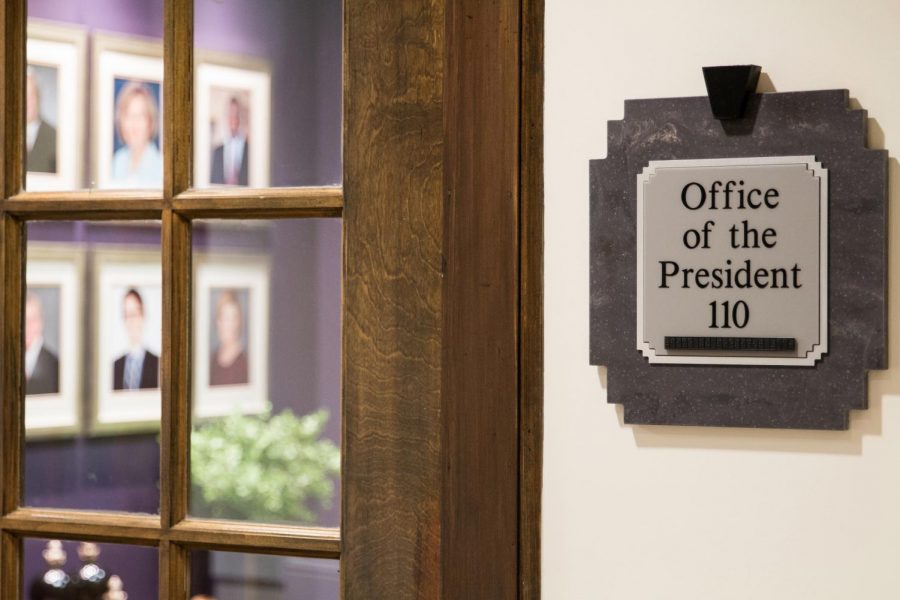Project 208 campaigns for more funding
February 24, 2019
If UNA President Kenneth Kitts’ Project 208 fails, students could face tuition hikes.
“We’re doing great things now,” Kitts said. “Think about what we could do at UNA if we were funded at a fair level. We have to keep this wonderful project going or the consequences will be lower enrollment and an increase in tuition for students.”
Kitts hopes Project 208 will be the key marker of his administration and the solution to obtain more state funding.
Project 208 is an initiative and effort to gain more funding for UNA. Currently, UNA ranks last as the least funded public four-year institution compared to peer institutions in Alabama, ranking last as No. 14, according to Kitts.
Kitts became the president of UNA in 2015, and he initiated Project 208 in November 2017.
“Project 208 is my brain child,” Kitts said. “At heart, Project 208 is about the fairness in the funding we need to continue to do great things at UNA.”
Kitts said UNA is $25 million underfunded each year.
As of now, Alabama does not have a system it uses to determine how funding is distributed among public four-year universities. Kitts said the majority of the state’s decisions rely on relationships between lawmakers in Montgomery and the individual universities.
Project 208 began to help bridge the gap in funding for UNA.
UNA does have a donation fund called the 1830 Fund. The 1830 Fund serves as the University of North Alabama Foundation’s annual, unrestricted fund.
Gifts designated to The 1830 Fund make a significant impact on students through supporting immediate campus needs as they arise, according to una.edu.
Kitts and his administration identified three key reasons for the imbalance in state funding.
“I think our geography, the fact that we are farther away from Montgomery than any of those other 13 schools, is part of the problem,” Kitts said.
Kitts named his campaign Project 208 because UNA is 208 miles from Montgomery.
“Other state universities are located in much closer proximity to Montgomery, which eases access and allows for a constant face-to-face dialogue between institutional and state officials about funding needs,” Kitts said.
The second factor that contributes to UNA’s lack of funding is the university’s location in a border county. If an individual drew a circle 50 miles out from the UNA campus, a large portion of UNA’s service territory falls in Mississippi and Tennessee.
Kitts explained that even though UNA has students from Tennessee and Mississippi, legislators from Tennessee and Mississippi are less likely to advocate for funding for a school in Alabama.
Kitts said there are no Alabama Senate or House districts to the north or west of Lauderdale County, so the size of UNA’s legislative delegation is small and has reduced UNA’s influence in Montgomery.
“Our local representatives and senators have been great to help UNA,” Kitts said. “They are dialed into Project 208 and doing everything in their power to help us.”
The third factor is UNA’s lack of alumni representation in the state Legislature.
“Some large universities have over 30 alumni serving in the House or Senate with regional schools having proportionately fewer representatives,” Kitts said.
UNA has only two elected state lawmakers from the alumni ranks.
Fourth, there are no Shoals-area representatives on the two key Education Trust Fund committees in the Legislature, one in the House of Representatives and the other in the Senate.
Kitts said these two committees play a crucial role in shaping higher education funding decisions in Montgomery.
“When you’re $23 million in the hole, and that is $23 million each year, every year, you are not going to get that much of an adjustment overnight,” Kitts said. “That’s not how Montgomery works.”
Project 208 is geared to bring more awareness to UNA’s funding, or lack thereof, issue.
Ross Alexander, vice president for academic affairs and provost, said UNA has experienced hardship in gaining equitable state funding in the past.
“Our budget is about $100 million,” he said. “We get about $28 million of that amount from the state, so in essence, if we were funded at the median level, our state funding would double.”
Kitts said communicating this issue to lawmakers in Montgomery, as well as alumni and stakeholders, is a vital second step in achieving Project 208’s goals.
Kitts said sharing the infographic and research on UNA’s inequity is important. Kitts meets with lawmakers, calls and meets with alumni and works closely with a governmental relations firm in Montgomery that provides expertise and guidance during the legislative process.
“In the long run, equality in state funding would allow UNA to offer more competitive scholarships, update facilities and support faculty and staff with the resources they need to serve students.,” Kitts said. “An increase in state dollars would also help limit future tuition increases.”
The swimming pool in Flowers Hall recently closed due to a lack of funding to fix $1 million worth of repairs.
“There was a report just last year from our Center for Innovation and Economic Development which concluded that UNA has a $316 million dollar per year economic impact on the Shoals,” Alexander said. “We are a huge economic driver in this region. Any additional funding that we get only expands that footprint.”
Last year, UNA officials applied for and received $5 million in the form of a local, non-recurring grant from the Shoals Economic Development Authority (SEDA). UNA also received a one-time contribution from the governor’s office totaling $3 million.
Both of these awards are tied to specific projects that assist with workforce development and regional economic development. The projects include funding for Laura M. Harrison Hall, the future home of Anderson College of Nursing and the addition of a chemical engineering degree in the Department of Engineering Technology.



![Caleb Crumpton [COURTESY OF UNA SGA]](https://theflorala.com/wp-content/uploads/2024/07/caleb-crumpton-courtesy-of-SGA-425x600.jpg)






